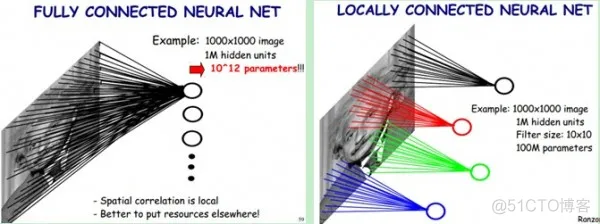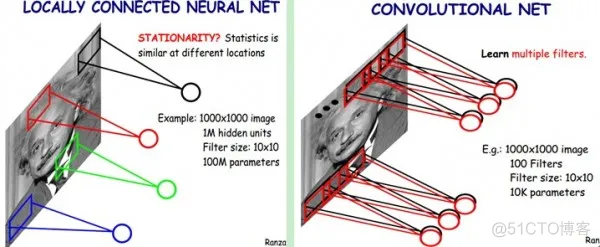如果全部使用神经网络,会导致权重过多,计算量增大,无法正常计算。
CNN个人理解为特征的提取,在不损失太多信息量的情况下,减小权重数量,使得网络更容易迭代。其中最重要的2个武器就是局部连接与共享权重
主要搞懂以下2张图的含义,就ok了:

图1:局部连接
全连接:如果我们使用全连接,原图像是1000*1000的图,隐层也设置成1000*1000层。所以全部的权重数为10^12。
局部连接:假设一个隐层的节点,我们只让它观察10*10的数据。所以全部的权重数量就是10^8。
以上就是局部连接的力量。

图2:共享权重
我们把上面那个10*10的过滤器(卷积)看做是一种抽取特征的方式,那么我们认为一个种过滤器对应的隐藏层的权重应该一样,所以一下子只需要1个节点。
但认为这样的特征抽取不靠谱,所以通常会用不同的过滤器。图右边就是用了100个filters所以我们就有10*10*100个权重。
顺带把池化层也说一下:
在卷积神经网络中,没有必要一定就要对原图像做处理,而是可以使用某种“压缩”方法,这就是池化,也就是每次将原图像卷积后,都通过一个下采样的过程,来减小图像的规模。
pooling的好处有什么?
1. 这些统计特征能够有更低的维度,减少计算量。
2. 不容易过拟合,当参数过多的时候很容易造成过度拟合。
3. 缩小图像的规模,提升计算速度。
如下图所示,原图是一张500∗500 的图像,经过subsampling之后哦,变成了一张 250∗250 的图像。这样操作的好处非常明显,虽然经过权值共享和局部连接后的图像权值参数已经大大减少,但是对于计算量来说,还是非常巨大,需要消费很大的计算时间,于是为了进一步减少计算量,于是加入了subsampling这个概念,不仅仅使图像像素减少了, 同时也减少计算时间。
举个栗子:以最大池化(Max Pooling)为例,1000×1000的图像经过10×10的卷积核卷积后,得到的是991×991的特征图,然后使用2×2的池化规模,即每4个点组成的小方块中,取最大的一个作为输出,最终得到的是496×496大小的特征图。
下采样,即池化,目的是减小特征图,池化规模一般为2×2。常用的池化方法有:
Pooling算法
最大池化(Max Pooling)。取4个点的最大值。这是最常用的池化方法。
均值池化(Mean Pooling)。取4个点的均值。
可训练池化。训练函数 f ,接受4个点为输入,出入1个点。
由于特征图的变长不一定是2的倍数,所以在边缘处理上也有两种方案:
保留边缘。将特征图的变长用0填充为2的倍数,然后再池化。
忽略边缘。将多出来的边缘直接省去。
核心思想:一个正向传播的权重为4比特,反向传播需要8比特进行计算所需要的内存。显内存约等于bach*权重数量*12比特
from tensorflow.examples.tutorials.mnist import input_data
import tensorflow as tf
sess = tf.InteractiveSession()
mnist = input_data.read_data_sets('MNIST_data',one_hot=True)
def compute_accuracy(v_xs, v_ys):
global prediction
y_pre = sess.run(prediction, feed_dict={xs: v_xs, keep_prob: 1})
correct_prediction = tf.equal(tf.argmax(y_pre,1), tf.argmax(v_ys,1))
accuracy = tf.reduce_mean(tf.cast(correct_prediction, tf.float32))
result = sess.run(accuracy, feed_dict={xs: v_xs, ys: v_ys, keep_prob: 1})
return result
def weight_variable(shape):
initial = tf.truncated_normal(shape, stddev=0.1)
return tf.Variable(initial)
def bias_variable(shape):
initial = tf.constant(0.1, shape=shape)
return tf.Variable(initial)
def conv2d(x, W):
# stride [1, x_movement, y_movement, 1]
# Must have strides[0] = strides[3] = 1
return tf.nn.conv2d(x, W, strides=[1, 1, 1, 1], padding='SAME')
def max_pool_2x2(x):
# stride [1, x_movement, y_movement, 1]
return tf.nn.max_pool(x, ksize=[1,2,2,1], strides=[1,2,2,1], padding='SAME')
# define placeholder for inputs to network
xs = tf.placeholder(tf.float32, [None, 784]) # 28x28
ys = tf.placeholder(tf.float32, [None, 10])
keep_prob = tf.placeholder(tf.float32)
x_image = tf.reshape(xs, [-1, 28, 28, 1])
# print(x_image.shape) # [n_samples, 28,28,1]
## conv1 layer ##
W_conv1 = weight_variable([5,5, 1,32]) # patch 5x5, in size 1, out size 32
b_conv1 = bias_variable([32])
h_conv1 = tf.nn.relu(conv2d(x_image, W_conv1) + b_conv1) # output size 28x28x32
h_pool1 = max_pool_2x2(h_conv1) # output size 14x14x32
## conv2 layer ##
W_conv2 = weight_variable([5,5, 32, 64]) # patch 5x5, in size 32, out size 64
b_conv2 = bias_variable([64])
h_conv2 = tf.nn.relu(conv2d(h_pool1, W_conv2) + b_conv2) # output size 14x14x64
h_pool2 = max_pool_2x2(h_conv2) # output size 7x7x64
## fc1 layer ##
W_fc1 = weight_variable([7*7*64, 1024])
b_fc1 = bias_variable([1024])
# [n_samples, 7, 7, 64] ->> [n_samples, 7*7*64]
h_pool2_flat = tf.reshape(h_pool2, [-1, 7*7*64])
h_fc1 = tf.nn.relu(tf.matmul(h_pool2_flat, W_fc1) + b_fc1)
h_fc1_drop = tf.nn.dropout(h_fc1, keep_prob)
## fc2 layer ##
W_fc2 = weight_variable([1024, 10])
b_fc2 = bias_variable([10])
prediction = tf.nn.softmax(tf.matmul(h_fc1_drop, W_fc2) + b_fc2)
# the error between prediction and real data
cross_entropy = tf.reduce_mean(-tf.reduce_sum(ys * tf
.log(prediction),reduction_indices=[1]))
train_step = tf.train.AdamOptimizer(1e-4).minimize(cross_entropy)
sess = tf.Session()
init = tf.global_variables_initializer()
sess.run(init)
for i in range(1000):
batch_xs, batch_ys = mnist.train.next_batch(100)
sess.run(train_step, feed_dict={xs: batch_xs, ys: batch_ys, keep_prob: 0.5})
if i % 50 == 0:
print(compute_accuracy(mnist.test.images, mnist.test.labels))
0.1546
0.814
0.8882
0.9064
0.9195
0.9315
0.9409
0.9426
0.9481
0.9508
0.9566
0.9552
0.9582
0.9602
0.9627
0.9654
0.9642
0.9652
0.9681
0.9665
免责声明:本文系网络转载或改编,未找到原创作者,版权归原作者所有。如涉及版权,请联系删